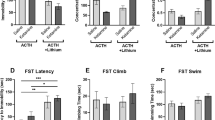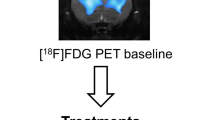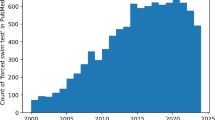Abstract
Aim:
To investigate the potential antidepressant and anxiolytic effects of Neu-P11, a novel melatonin agonist, in two models of depression in rats and a model of anxiety in mice.
Methods:
In the learned helplessness test (LH), Neu-P11 or melatonin (25–100 mg/kg, ip) was administered to rats 2 h before the beginning of the dark phase once a day for 5 days and the number of escape failures and intertrial crossings during the test phase were recorded. In the forced swimming test (FST), rats received a single or repeated administration of Neu-P11 (25–100 mg/kg, ip). The total period of immobility during the test phase was assessed. In the elevated plus-maze test (EPM), mice were treated with Neu-P11 (25–100 mg/kg, ip) or melatonin in the morning or in the evening and tested 2 h later. The percentage of time spent in the open arms and the open arms entries were assessed.
Results:
In the LH test, Neu-P11 but not melatonin significantly decreased the escape deficit and had no effect on the intertrial crossings. In the FST, a single or repeated administration of Neu-P11, either in the morning or in the evening, significantly decreased the duration of immobility. In the EPM test, Neu-P11 significantly increased the percentage of time spent in the open arms and the open arms entries irrespective to the time of administration. Melatonin was effective only when administered in the afternoon.
Conclusion:
The results demonstrate that Neu-P11 exerts antidepressant and anxiolytic activities in rodent models.
Similar content being viewed by others
Log in or create a free account to read this content
Gain free access to this article, as well as selected content from this journal and more on nature.com
or
References
Wong ML, Licinio J . Research and treatment approaches to depression. Nat Rev Neurosci 2001; 2: 343–51.
Greenberg PE, Kessler RC, Birnbaum HG, Leong SA, Lowe SW, Berglund PA, et al. The economic burden of depression in the United States: how did it change between 1990 and 2000? J Clin Psychiatry. 2003; 64: 1465–75.
Murphy SL . Deaths: final data for 1998. Natl Vital Stat Rep 2000; 48: 1–106.
Harris EC, Barraclough B . Excess mortality of mental disorder. Br J Psychiatry 1998; 173: 11–53.
Glassman AH, Shapiro PA . Depression and the course of coronary artery disease. Am J Psychiatry 1998; 155: 4–11.
Lenox RH, Frazer A . Mechanism of action of antidepressants and mood stabilizers. In: Davis KL, Charney D, Coyle JT, Nemeroff C, editors. Neuropsychopharmacology: the fifth generation of progress. Philadelphia: Williams & Wilkins; 2002. p 1139–63.
Nash J, Nutt D . Antidepressants. Psychiatry 2007; 6: 289–94.
Hudson JL, Gradisar M, Gamble A, Schniering CA, Rebelo I . The sleep patterns and problems of clinically anxious children. Behav Res Ther 2009; 47: 339–44.
Srinivasan V, Pandi-Perumal SR, Trakht I, Spence DW, Hardeland R, Poeggeler B, et al. Pathophysiology of depression: role of sleep and the melatonergic system. Psychiat Res 2009; 165: 201–14.
Takeuchi T, Nakao M, Nomura K, Yano E . Association of metabolic syndrome with depression and anxiety in Japanese men. Diabetes Metab 2009; 35: 32–6.
Kupfer DJ, Spiker DG, Coble PA, Neil JF, Ulrich R, Shaw DH . Sleep and treatment prediction in endogenous depression. Am J Psychiat 1981; 138: 429–34.
Armitage R, Hoffmann RF . Sleep EEG, depression and gender. Sleep Med Rev 2001; 5: 237–46.
Hubain P, Le Bon O, Vandenhende F, Van Wijnendaele R, Linkowski P . Major depression in males: effects of age, severity and adaptation on sleep variables. Psychiat Res 2006; 145: 169–77.
Lustberg L, Reynolds CF . Depression and insomnia: questions of cause and effect. Sleep Med Rev 2000; 4: 253–62.
Riemann D, Berger M, Voderholzer U . Sleep and depression-results from psychobiological studies: an overview. Biol Psychol 2001; 57: 67–103.
Dubocovich ML, Markowska M . Functional MT1 and MT2 melatonin receptors in mammals. Endocrine 2005; 27: 101–10.
Arendt J . Melatonin and human rhythms. Chronobiol Int 2006; 23: 21–37.
Redman J, Armstrong S, Ng KT . Free-running activity rhythms in the rat: entrainment by melatonin. Science 1983; 219: 1089–91.
Arendt J, Skene DJ . Melatonin as a chronobiotic. Sleep Med Rev 2005; 9: 25–39.
Lemoine P, Nir T, Laudon M, Zisapel N . Prolonged-release melatonin improves sleep quality and morning alertness in insomnia patients aged 55 years and older and has no withdrawal effects. J Sleep Res 2007; 16: 372–80.
Dahlitz M, Alvarez B, Vignau J, English J, Arendt J, Parkes JD . Delayed sleep phase syndrome response to melatonin. Lancet 1991; 337: 1121–4.
Srinivasan V, Smits G, Kayumov L, Pandi-Perumal SR, Cardinali DP, Thorpy MJ . Melatonin in circadian rhythm sleep disorders. In: Cardinali DP, Pandi-Perumal SR, editors. Neuroendocrine correlates of sleep/wakefulness. New York: Springer; 2006. p 269–94.
Barden N, Shink E, Labbé M, Vacher R, Rochford J, Mocaёr E . Antidepressant action of agomelatine (S 20098) in a transgenic mouse model. Prog Neuro-Psychoph Biol Psychiat 2005; 29: 908–16.
Bertaina-Anglade V, Rochelle CD, Boyer PA, Mocaёr E . Antidepressant-like effects of agomelatine (S 20098) in the learned helplessness model. Behav Pharmacol 2006; 17: 703–13.
Bourin M, Mocaer E, Porsolt R . Antidepressant-like activity of S 20098 (agomelatine) in the forced swimming test in rodents: involvement of melatonin and serotonin receptors. J Psychiatry Neurosci 2004; 29: 126–33.
Golombek DA, Martini M, Cardinali DP . Melatonin as an anxiolytic in rats: time dependence and interaction with the central GABAergic system. Eur J Pharmacol 1993; 237: 231–6.
Kopp C, Vogel E, Rettori MC, Delagrange P, Misslin R . Anxiolytic-like properties of melatonin receptor agonists in mice: involvement of mt1 and/or MT2 receptors in the regulation of emotional responsiveness. Neuropharmacology 2000; 39: 1865–71.
Mantovani M, Michel Bonetti K, Calixto JB, Santos AR, Rodrigues ALS . Antidepressant-like effect of melatonin in the tail suspension test in mice: evidence for involvement of N-methyl-D-aspartate receptors and the L-arginine-nitric oxide pathway. Neurosci Lett 2003; 343: 1–4.
Micale V, Arezzi A, Rampello L, Drago F . Melatonin affects the immobility time of rats in the forced swim test: The role of serotonin neurotransmission. Eur Neuropsychopharm 2006; 16: 538–45.
Overstreet DH, Pucilowski O, Retton MC, Delagrande P, Guardiola-Lemaitre B . Effects of melatonin receptor ligands on swim test immobility. Neuroreport 1998; 9: 249–53.
Papp M, Gruca P, Boyer PA, Mocaёr E . Effect of agomelatine in the chronic mild stress model of depression in the rat. Neuropsychopharmacol 2003; 28: 694–703.
Papp M, Litwa E, Gruca P, Mocaёr E . Anxiolytic-like activity of agomelatine and melatonin in three animal models of anxiety. Behav Pharmacol 2006; 17: 9–18.
Raghavendra V, Kaur G, Kulkarni SK . Anti-depressant action of melatonin in chronic forced swimming-induced behavioral despair in mice, role of peripheral benzodiazepine receptor modulation. Eur Neuropsychopharm 2000; 10: 473–81.
Shaji AV, Kulkarni SK . Central nervous system depressant activities of melatonin in rats and mice. Ind J Exp Biol 1998; 36: 257–63.
Dalton EJ, Rotondi D, Levitan RD, Kennedy SH, Brown GM . Use of slow-release melatonin in treatment-resistant depression. J Psychiatry Neurosci 2000; 25: 48–52.
Norman TR, Burrows GD . Emerging treatments for major depression. Expert Rev Neurother 2007; 7: 203–13.
Zawilska JB, Skene DJ, Arendt J . Physiology and pharmacology of melatonin in relation to biological rhythms. J Pharmacol Rep 2009; 61: 383–410.
She M, Deng X, Guo Z, Laudon M, Hu Z, Liao D, et al. Neu-P11, a novel melatonin agonist, inhibits weight gain and improves insulin sensitivity in high-fat/high-sucrose-fed rats. Pharmacol Res 2009; 59: 248–53.
Laudon M, Urade Y, Huang Z . Neu-P11, a novel melatonin agonist: effects on sleep and EEG power spectra in rats. Sleep 2008; 31 Suppl: A34–35.
Fu J, Li P, Ouyang X, Gu C, Song Z, Gao J, et al. Rapid eye movement sleep deprivation selectively impairs recall of fear extinction in hippocampus-independent tasks in rats. Neuroscience 2007; 144: 1186–92.
Gu C, Li P, Hu B, Ou-yang X, Fu J, Gao J, et al. Chronic morphine selectively impairs cued fear extinction in rats: implications for anxiety disorders associated with opiate use. Neuropsychopharmacology 2008; 33: 666–73.
Raupp IM, Sereniki A, Virtuoso S, Ghislandi C, Silva ELC, Trebien HA, et al. Anxiolytic-like effect of chronic treatment with Erythrina velutina extract in the elevated plus-maze test. J Ethnopharmacol 2008; 118: 295–9.
Vargas KM, Da Cunha C, Andreatini R . Amphetamine and pentylenetetrazole given post-trial 1 enhance one-trial tolerance to the anxiolytic effect of diazepam in the elevated plus-maze in mice. Prog Neuro-Psychoph Biol Psychiat 2006; 30: 1394–402.
Liu Z, Zhang H, Ye N, Zhang J, Wu Q, Sun P, et al. Synthesis of dihydrofuroaporphine derivatives: identification of a potent and selective serotonin 5-HT1a receptor agonist. J Med Chem 2010; 53: 1319–28.
Mustonen AM, Nieminen P, Hyvärinen H . Effects of continuous light and melatonin treatment on energy metabolism of the rat. J Endocrinol Invest 2002; 25: 716–23.
Gaffori O, Van Ree JM . Serotonin and antidepressant drugs antagonize melatonin-induced behavioural changes after injection into the nucleus accumbens of rats. Neuropharmacology 1985; 24: 237–44.
Eison AS, Freeman P, Guss VB, Mullins UL, Wright RN . Melatonin agonists modulate 5-HT2a receptor-mediated neurotransmission: behavioral and biochemical studies in the rat. J Pharmacol Exp Ther 1995; 273: 304–8.
Raghavendra V, Kaur G, Kulkarni SK . Anti-depressant action of melatonin in chronic forced swimming-induced behavioral despair in mice, role of peripheral benzodiazepine receptor modulation. Eur Neuropsychopharmacol 2000; 10: 473–81.
Hill MN, Brotto LA, Lee TT, Gorzalka BB . Corticosterone attenuates the antidepressant-like effects elicited by melatonin in the forced swim test in both male and female rats. Prog Neuro-psychopharmacol Biol Psychiatry 2003; 27: 905–11.
AcuÑa-Castroviejo D, Rosenstein RE, Romeo HE, Cardinali DP . Changes in gamma-aminobutyric acid high affinity binding to cerebral cortex membranes after pinealectomy or melatonin administration to rats. Neuroendocrinology 1986; 43: 24–31.
Niles LP, Pickering DS, Arxiszewski MA . Effect of chronic melatonin administration on GABA and diazepam binding in rat brain. J Neural Transm 1987; 70: 117–24.
Rosenstein RE, Cardinali DP . Melatonin increases in vivo GABA accumulation in rat hypothalamus, cerebellum, cerebral cortex and pineal gland. Brain Res 1986; 398: 403–6.
Rosenstein RE, Estevez AG, Cardinali DP . Time-dependent effect of melatonin on glutamic acid decarboxylase activity and 36Cl− influx in rat hypothalamus. J Neuroendocrinol 1989; 1: 443–7.
Sanger DJ, Joly D, Deportere H, Zivkovic B, Lloyd KG . Behavioral profile of progabide in test for anxiolytic and anti-depressant drugs. In: Bartholini G, Lloyd KG, Morselli PL, editors. GABA and mood disorders. New York: Raven Press; 1996. p 77–84.
Mantovani M, Michel Bonetti K, Calixto JB, Santos AR, Rodrigues ALS . Antidepressant-like effect of melatonin in the tail suspension test in mice: evidence for involvement of N-methyl-D-aspartate receptors and the L-arginine-nitric oxide pathway. Neurosci Lett 2003; 343: 1–4.
Deakin J . A review of clinical efficacy of 5-HT1a agonists in anxiety and depression. J Psychopharmacol 1993; 7: 283–9.
Overstreet DH, Commissaris RC, De La Garza II R, File SE, Knapp DJ, Seiden LS . Involvement of 5-HT1a receptors in animal tests of anxiety and depression: evidence from genetic models. Stress 2003; 6: 101–10.
Sibille E, Sarnyai Z, Benjamin D, Gal J, Baker H, Toth M . Antisense inhibition of 5-hydroxytryptamine2a receptor induces an antidepressant-like effect in mice. Mol Pharmacol 1997; 52: 1056–63.
Patel JG, Bartoszyk GD, Edwards E, Ashby CR Jr . The highly selective 5-hydroxytryptamine (5-HT) 2a receptor antagonist, EMD 281014, significantly increases swimming and decreases immobility in male congenital learned helpless rats in the forced swim test. Synapse 2004; 52: 73–5.
Jenck F, Bos M, Wichmann J, Stadler H, Martin JR, Moreau JL . The role of 5-HT2c receptors in affective disorders. Exp Opin Invest Drugs 1998; 7: 1587–99.
Pinder RM . The pharmacologic rationale for the clinical use of antidepressants. J Clin Psychiatry 1997; 58: 501–8.
Gorzalka BB, Brotto LA, Hong JJ . Corticosterone regulation of 5-HT2a receptor-mediated behaviors: attenuation by melatonin. Physiol Behav 1999; 67: 439–42.
Monnet FP . Melatonin modulates [3H]serotonin release in the rat hippocampus: effects of circadian rhythm. J Neuroendocrinol 2002; 14: 194–9.
Acknowledgements
This study was supported by A Project 30770689 Supported by National Natural Science Foundation of China and Neurim Pharmaceuticals Research Grant to S Tian. The authors wish to thank Dr Matthew LEWIS for his editorial help.
Author information
Authors and Affiliations
Corresponding author
Rights and permissions
About this article
Cite this article
Tian, Sw., Laudon, M., Han, L. et al. Antidepressant- and anxiolytic effects of the novel melatonin agonist Neu-P11 in rodent models. Acta Pharmacol Sin 31, 775–783 (2010). https://doi.org/10.1038/aps.2010.80
Received:
Accepted:
Published:
Issue date:
DOI: https://doi.org/10.1038/aps.2010.80
Keywords
This article is cited by
-
Chronic Piromelatine Treatment Alleviates Anxiety, Depressive Responses and Abnormal Hypothalamic–Pituitary–Adrenal Axis Activity in Prenatally Stressed Male and Female Rats
Cellular and Molecular Neurobiology (2022)
-
Chronic administration of parecoxib exerts anxiolytic-like and memory enhancing effects and modulates synaptophysin expression in mice
BMC Anesthesiology (2017)
-
Behavior, Memory, and Immunological Status in Mice in a Model of Desynchronosis
Neuroscience and Behavioral Physiology (2016)
-
Piromelatine ameliorates memory deficits associated with chronic mild stress-induced anhedonia in rats
Psychopharmacology (2016)
-
Exploration on Mechanism of a New Type of Melatonin Receptor Agonist Neu-p11 in Hypoxia–Reoxygenation Injury of Myocardial Cells
Cell Biochemistry and Biophysics (2014)



